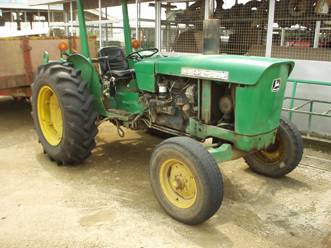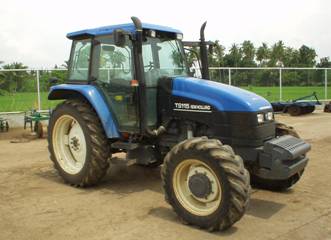Four-wheel tractors can be divided into 3 categories;
- two wheel drive,
- front wheel assist or unequal four wheel drive and
- equal four wheel drive tractors.
Each one of these tractors has different tire configurations and different ballast requirements.
Two Wheel Drive tractors (2WD) are the most commonly used tractors in dry or upland farming situations and for transportation.
They range in size from 4-150 kW and need 80% of the weight distributed over the rear axle to maximize traction. These tractors are capable of delivering 45-50% of their rated engine power at the drawbar.
The biggest advantage of this type of tractor over other 4 wheel tractors is:
- Smaller turning circle,
- Simplicity of design,
- Fewer mechanical parts, and
- Lower purchase price.

Front
Wheel Assist or Unequal Four Wheel Drive (FWA) is the most popular
4 wheel tractor used in rice production.
These tractors range in size from 4-180 kW and are capable of delivering
between 50-55% of the rated power at the drawbar. As the name suggests
the front drive tires, whilst larger than two wheel drive tractors, are
smaller than the rear tires. Front wheel drive should be used at all times
when the tractor is working in the field. If not at least 10% efficiency
will be lost.

A major disadvantage is that this tractor type has more mechanical failures, displays unequal tire wear front to rear and is less maneuverable than a 2 wheel drive tractor.The biggest disadvantage is the inability to work in very wet and muddy conditions.
Depending on the make and model, the new purchase price of a 4 wheel tractor ranges from $US150-450 per kW or $110-330 per hp. One 60kW tractor is capable of ploughing 7-8ha per day or 1 ha/hr. Fuel consumption is dependent on engine size, make of machine, working conditions and operator skill. A general rule of thumb is that 1kW of engine power will need 0.25 litres of fuel/hour.

Very few of these tractors are used in rice production in Asia because of their large size, greater turning radius and purchase price